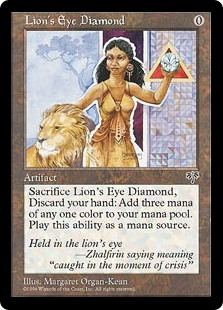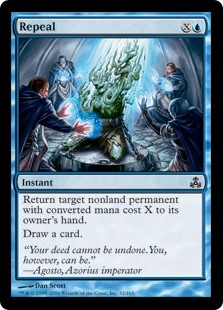Tendrils of Agony in Legacy, 2004–2008
Tendrils of Agony in competitive Legacy has been defined by the full legal usage of Lion's Eye Diamond. I don't want to merely rehash the LED Memories thread, which covered much of this. And really, having followed Legacy since the format's inception and having focused on combo decks, there's really
too much I could say about this stuff, ranging from the evolution of The Epic Storm to the elusive Eggs Tendrils to Charbelcher hybrids to my own experiments with Meditate and Infernal Contract. I wish I'd done more to catalog my own failed Legacy decks. Oh yes, I built and extensively tested Tendrils decks in early Legacy. Some of my own brews were unlike anything that saw the light of day in tournament records. This wasn't due to any unwillingness on my part to participate in tournaments. It was just that with work and school going on, I was too busy. Also, I was mostly using Apprentice and proxies and couldn't afford to assemble real, legal versions of some of my concoctions. Going roughly by memory, a lot of my experiments involved the use of Meditate, a strong card that never seemed to make its way into tournament Storm lists.
I say 2004–2008 because
Shards of Alara changed everything when it introduced Ad Nauseam to the format. Before that point, Tendrils decks struggled, mostly in vain, to compete in Legacy tournaments, and most of the successes came from IGGy-Pop.
My qualm with this was that this version of Storm relied on graveyard recursion to win, which made it ultimately no less vulnerable to graveyard hate than a dedicated Reanimator deck, with little to make up for that. As I noted in the LED thread, IGG served as the poor man's Yawgmoth's Will and was the power behind Tendrils decks in the early years of Legacy. New sets coming out after 2004 actually gave Legacy combo decks
a lot to work with, such as Rite of Flame, Infernal Tutor, Sensei's Divining Top, Ponder, Street Wraith, Empty the Warrens, and Pact of Negation. This enabled new archetypes like The Epic Storm and Fetchland Tendrils, which still used IGG, but didn't rely on it 100% and could easily still win through graveyard hate. A vital innovation, which was too good not to use, was the Infernal Tutor + LED combo.


Again, some of this material is probably already covered in the LED thread. I'm covering old ground here. If you really just want to cast the card that you are going to tutor for and discarding your hand doesn't matter (or is even beneficial), then you can activate any number of copies of Lion's Eye Diamond you happen to have and use their mana to pay for whatever broken thing you're doing, often Tendrils of Agony. LED turns Infernal Tutor into Demonic Tutor, and Infernal Tutor turns LED into Black Lotus. Both cards can be used independently of each other: Infernal Tutor can help with hand-sculpting to boost mana production and LED can be used alongside Ill-Gotten Gains. The cards were used together in tutor chains. Without an example on-hand, I'll just try to roughly describe it. A combo player would go for a tutor chain if the opening hand and matchup looked like it would allow for such an approach. The first couple of turns would be spent dropping lands and casting cantrips or targeted discard spells, sculpting one's own hand to prepare for the kill turn and sizing the opponent up. The Storm player would either have LED in hand or would dig for it, saving mana-producing cards in-hand and using any spare copies of Infernal Tutor to pull more copies of LED out of the library. Then, all at once, any mana-producing cards would be deployed (Dark Ritual, Rite of Flame, Cabal Ritual, Lotus Petal, Lion's Eye Diamond) and Infernal Tutor would be cast with Hellbent, using up those Lion's Eye Diamonds and producing an excess of mana, allowing Infernal Tutor to search for Infernal Tutor, chaining them into each other and using the last one to find Tendrils of Agony, which will be lethal because of how many spells were cast in the same turn. In some decks, mostly The Epic Storm, Burning Wish could be added on to the tutor chain. This technique is mana-intensive and won't work if the opponent was able to hide countermagic from discard spells by using Brainstorm, but it is immune to graveyard hate, is somewhat robust against disruption because it doesn't rely on leaving permanents such as creature or artifacts on the battlefield, and isn't dependent on the Storm player's life total. Assessing the opponent's clock and level of disruption and weighing it against the amount of mana one can generate for tutor chains is a fundamental skill in piloting Legacy Tendrils decks.
In the LED thread, I emphasized The Epic Storm, a deck characterized by the use of Rite of Flame, Burning Wish, and Empty the Warrens, serving as a kind of hybrid between Empty the Warrens and Tendrils of Agony and flexibly going for the kill with either depending on the situation. Another achetype was Fetchland Tendrils, which was similar to IGGy-Pop, but took advantage of the synergy between Sensei's Divining Top and the Onslaught fetchlands to control topdecks and move away from a reliance on graveyard recursion. Sometimes they used Infernal Contract to help power out Tendrils kills...
...and starting in about 2007, they began incorporating Doomsday, to set up yet another option for Tendrils decks. This led to Doomsday Fetchland Tendrils. DDFT continued to exist as a kind of rogue Legacy tournament deck from 2007 all the way to 2017, when Sensei's Divining Top was banned. Doomsday decks are notoriously tricky to pilot.
That covers most of it, but there was one other major Tendrils archetype in Legacy pre-2008, which I haven't mentioned yet...

